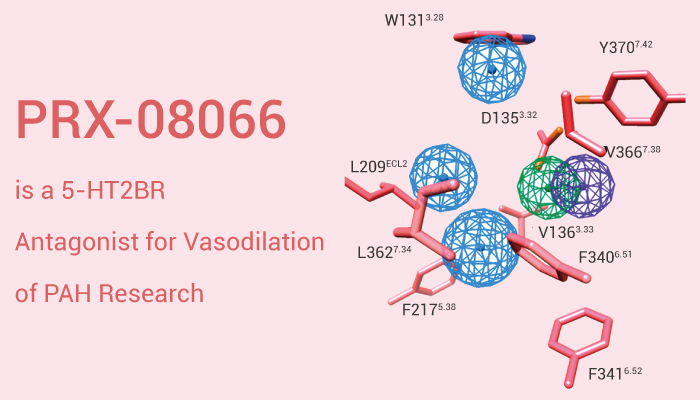Pulmonary arterial hypertension (PAH) is an increased pulmonary arterial pressure caused by vasoconstriction and pulmonary vascular remodeling. In addition, 5-hydroxytryptamine (5-HT) plays a role in the development of PAH. Specifically, 5-HT remodels the pulmonary vasculature by vasoconstriction, platelet aggregation, and pulmonary arterial smooth muscle cell proliferation. As for 5-HT receptors, 5-HT2B receptors (5-HT2BR) takes part in the pathobiology of PAH. Generally, 5-HT2BR are expressed in pulmonary endothelial and smooth muscle cells, and stimulates calcium release in human endothelial cells. Moreover, PRX-08066 is a highly potent and selective 5-HT2BR antagonist (Ki: 3.4 nM). It causes vasodilation of pulmonary arteries, and can be used for research of PAH.

PRX-08066, a selective 5-HT2BR antagonist, can be used for pulmonary arterial hypertension (PAH) research.
PRX-08066 is a potent, orally active and selective 5-HT2BR antagonist, with a Ki value of 3.4 nM. Specifically, In vitro, PRX-08066 inhibits 5-HT induced MAPK activation (IC50: 12 nM), and reduces thymidine incorporation (IC50: 3 nM) in Chinese hamster ovary cells expressing h5-HT2BR. In KRJ-I cells, PRX-08066 also inhibits cell proliferation (24 h, IC50: 0.46 nM), as well as basal and isoproterenol-stimulated 5-HT secretion (2 h, IC50: 6.9 nM and 1.25 nM respectively).
In vivo, PRX-08066 (50 or 100 mg/kg, oral gavage, twice a day for 5 weeks) improves right ventricular ejection fraction in a Monocrotaline-induced PAH rat model. At the same time, PRX-08066 decreases pulmonary arteries pressure and right ventricle hypertrophy.
In conclusion, PRX-08066 is a selective and orally active 5-HT2BR antagonist. PRX-08066 is effective against pulmonary arterial hypertension (PAH).
References:
[1] Porvasnik SL, et al. J Pharmacol Exp Ther. 2010 Aug;334(2):364-72.
[2] Svejda B, et al. Cancer. 2010 Jun 15;116(12):2902-12.